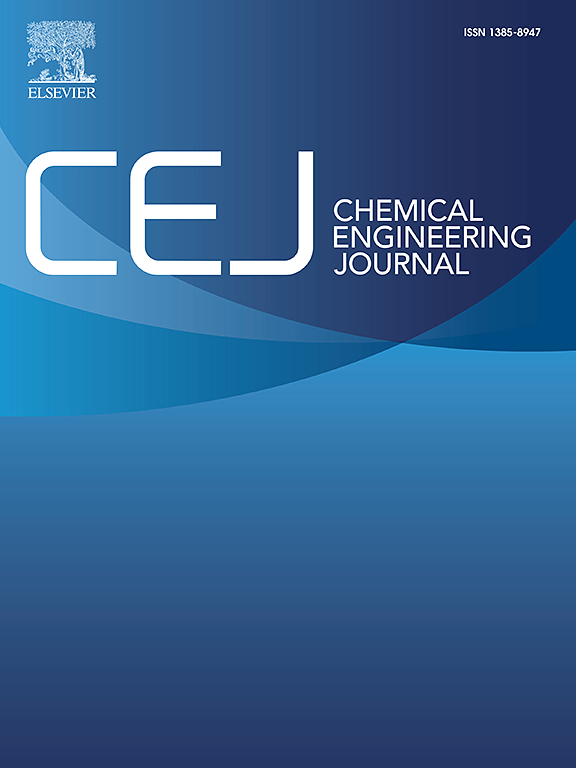Development of high crystalline and robust ionic COFs nanofiltration membranes for dyes/salts separation via facile microwave technique
IF 13.2
1区 工程技术
Q1 ENGINEERING, CHEMICAL
引用次数: 0
Abstract
Fabrication of high crystalline, robust and continuous covalent organic frameworks (COFs) nanofiltration membranes based on green solvents is promising yet highly challenging. Here, we prepared robust COFs membranes by facile microwave-assisted technique using water as the solvent involved in the reaction. Initially, we prepared TbPa-SO3H COFs suspensions containing cetyltrimethylammonium bromide (CTAB) by Schiff base reaction. Subsequently, using household microwave-assisted solvent evaporation technology, the TbPa-SO3H suspension could be deposited on the polyacrylonitrile (PAN) support membrane to form high crystalline TbPa-SO3H separation layer in just a few minutes, thus transforming it from amorphous to crystalline state. Due to its high crystallinity, the obtained TbPa-SO3H membranes exhibited high rejection for common dyes (96% for Congo red, MW 696.5 Da), low salts rejection (1.21% for NaCl) and high pure water flux (109 L m−2h−1bar−1). To our surprise, the obtained COFs membranes remained their original structure after numerous cycles of use, continuous filtration and high pressure (7 bar) operating conditions. Microwave-assisted preparation of COFs membranes strategy lays a solid foundation for a new generation of crystalline membrane materials and precise separation.

微波技术用于染料/盐分离的高结晶性强离子COFs纳滤膜的研制
基于绿色溶剂的高结晶、坚固和连续的共价有机框架(COFs)纳滤膜的制造是有前途的,但也极具挑战性。本研究以水为溶剂,采用微波辅助技术制备了坚固的COFs膜。首先,我们通过希夫碱反应制备了含有十六烷基三甲基溴化铵(CTAB)的tppa - so3h COFs悬浮液。随后,利用家用微波辅助溶剂蒸发技术,将TbPa-SO3H悬浮液沉积在聚丙烯腈(PAN)支撑膜上,在短短几分钟内形成高结晶TbPa-SO3H分离层,使其由无定形转变为结晶态。由于其高结晶度,所制得的TbPa-SO3H膜对常见染料的截留率高(刚果红96%,MW 696.5 Da),对盐的截留率低(NaCl 1.21%),纯水通量高(109 L m−2h−1bar−1)。令我们惊讶的是,经过多次循环使用,连续过滤和高压(7 bar)操作条件后,获得的COFs膜仍保持其原始结构。微波辅助制备COFs膜策略为新一代晶体膜材料的精确分离奠定了坚实的基础。
本文章由计算机程序翻译,如有差异,请以英文原文为准。
求助全文
约1分钟内获得全文
求助全文
来源期刊

Chemical Engineering Journal
工程技术-工程:化工
CiteScore
21.70
自引率
9.30%
发文量
6781
审稿时长
2.4 months
期刊介绍:
The Chemical Engineering Journal is an international research journal that invites contributions of original and novel fundamental research. It aims to provide an international platform for presenting original fundamental research, interpretative reviews, and discussions on new developments in chemical engineering. The journal welcomes papers that describe novel theory and its practical application, as well as those that demonstrate the transfer of techniques from other disciplines. It also welcomes reports on carefully conducted experimental work that is soundly interpreted. The main focus of the journal is on original and rigorous research results that have broad significance. The Catalysis section within the Chemical Engineering Journal focuses specifically on Experimental and Theoretical studies in the fields of heterogeneous catalysis, molecular catalysis, and biocatalysis. These studies have industrial impact on various sectors such as chemicals, energy, materials, foods, healthcare, and environmental protection.
 求助内容:
求助内容: 应助结果提醒方式:
应助结果提醒方式:


